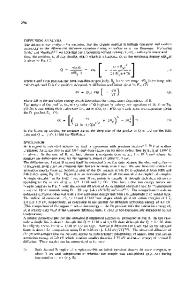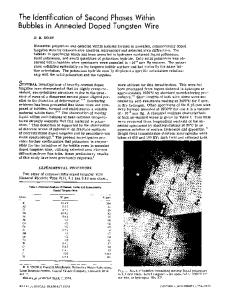Tungsten wire for incandescent lamps
- PDF / 3,670,866 Bytes
- 19 Pages / 593.28 x 841.68 pts Page_size
- 14 Downloads / 321 Views
Tungsten wire for incandescent lamps John L. Walter and Clyde L. Briant General Electric Corporate Research and Development, Schenectady, New York 12301 (Received 4 April 1990; accepted 18 May 1990)
Tungsten wire for incandescent lamp filaments must operate at high temperatures and for long times. To meet these requirements, the grain morphology of the wire must be controlled to reduce the propensity for grain boundary sliding. The morphology is a function of the distribution of very small pockets of potassium in the wire and the mechanical processing from ingot to wire. The behavior of the filament is directly related to the grain morphology. This paper describes the mechanism by which the potassium is incorporated into and distributed in the ingot. The elongation and spheroidization of the bubbles during hot rolling and swaging are also examined and related to the grain morphology of wire. Some indications of the relationship between grain morphology and filament behavior are also given. I. INTRODUCTION
II. DOPING AND REDUCTION OF BLUE OXIDE
Tungsten wire to be used for filaments in modern incandescent lamps must operate at higher temperatures and for longer times than has been the case in the past. To meet these requirements, the grain morphology of the wire must be controlled to reduce the propensity for grain boundary sliding. The morphology is a function of the distribution of the second phases in the wire and the mechanical processing (including intermediate anneals) from ingot to wire. The behavior of the filament is directly related to the grain morphology of the wire. The most common second phase found in lamp quality wire is potassium in the form of small bubbles. The potassium is added, along with silicon and aluminum, to the tungsten blue oxide. During reduction of the doped oxide in hydrogen, the potassium is incorporated into the tungsten crystals. The pockets or bubbles of potassium are then formed into strings of very small bubbles by the high temperature unidirectional rolling, swaging, and drawing to the final wire diameter. An example of the strings of bubbles (arrows) in a fully recrystallized wire is given in Fig. 1. At room temperature, these bubbles are coated with a shell of solid potassium. During processing of the wire and operation of the filament, the bubbles will be filled with potassium vapor. This paper describes the mechanism by which the potassium is incorporated into the ingot and how the all-important distribution of the potassium bubbles is achieved in the ingot. The elongation and spheroidization of the bubbles during hot rolling and swaging are also examined and related to void growth on the grain boundaries of the filaments as well as to the grain morphology of the wire. Some indications of the relationship between grain morphology and filament behavior are also given.
The starting material for the preparation of tungsten blue oxide is ammonium paratungstate (APT) [5(NH4)2O 12WO3 5H2O]. The blue oxide is obtained by heating APT in hydrogen at 700° to 900 K (430° to 650 °C
Data Loading...











